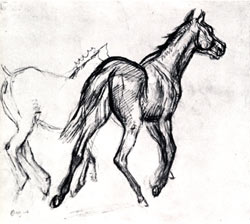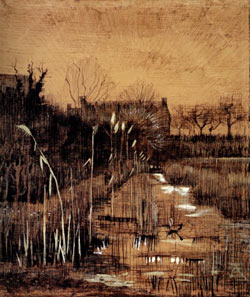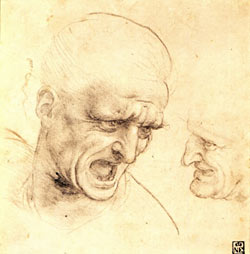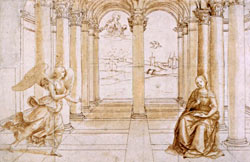Drawing is not the easiest of words to pin down as even paintings made entirely with a brush are in essence drawings. For the puposes of this guide I shall simply refer to it as marking lines and curves in a relationship to one another – the more cohesive that relationship, the more resemblence it will have to your subject. Colour can remain excluded from the definition for now, though shading is the process that transforms these lines and curves into something more concrete and solidified.
 Degas - Two Trotting Horses
Degas - Two Trotting Horses“What is art?” is a question without answer. It is possible to enjoy a recognised and profitable art career without needing to hone any drawing skills, though that is not to acknowledge that many a modern artist has gone through a disciplined and academic form of study before settling into their niche. This type of art however, is deeply personal, intuitive and cannot be teached, and so this guide therefore aims to teach drawing/sketching as a reasonable interpretation and likeness of what we “see”, and with an arsenal of tips and techniques at your fingertips, personal styles will develop based on emotional responses which may pave the way for anything from abstraction to photorealism.
Drawing is intrinsically linked to seeing; perhaps it sounds absurd to suggest we might need to learn ‘how to see’, given most are gifted with this ability from birth. It is only when we take to art that we begin to recognise imagination and conception produces a fairly subjective recreation of what actually is. The discerning eye of an artist has to be quite analytical of what lies before it, seeking patterns, shapes, relationships, direction, form, shadow, texture, depth, perspective, reflection, contrast… it nearly always demands a great deal of concentration, often to the detriment of our objectivity and a chance to view our work again through new eyes.
 Van Gogh - Ditch
Van Gogh - DitchDrawing is merely the co-ordination of the hand in response to the brain's spatial interpretation of shapes and form. Some may be innately more adapted to seeing the world in a way that can be deconstructed and recreated on a piece of paper, but take heart in knowing that seeing and drawing are without a shadow of a doubt, learnable processes capable by any person. The reason it might appear ‘magical’ to the non-artist (and that’s not to say artists are not often awed by another artist’s work!), is art is not properly developed throughout the education system… When I was at school it had the reputation of a drop-out subject, but the sad truth probably lies closer to a capitalistic work ethic.
The use and importance of drawing should firstly be directed toward yourself – your psychological well-being. Art is cathartic; the ability to express ourselves without fumbling over words makes it, in many ways, more akin to music. Artists, generally speaking, are part of the introverted populous of society, content in their own company, where the noise of the world is drowned and a sense of self is rediscovered.
Drawing in itself is a transferable skill that eases the transition into other mediums. Take watercolours as an example: they are a very popular medium amongst beginners, probably due to their relative cheapness, their non-toxicity, the amount of books/videos available on the subject and the wide selection of colours sold, not to mention the speed at which watercolours can render a scene (very little drying time required). Now there is nothing wrong in taking this approach, it is the same road I ventured down (though with disastrous results that nearly led to the abandonment of art I might add!) In hindsight the difficulties are quite apparent – firstly I was unconsciously teaching myself how to draw with a brush, at the same time as learning how to mix and use colour and with a medium that is notorious at producing accidents and unpredictable results! Undoubtedly an individual can take to art in this manner and become very proficient, but it did not strike me as being the most effective way to progress. Removing colour allows us to focus on drawing and values (dark to light shades); to understand value and contrast then makes it easier to return to colour with a greater knowledge on how to reproduce form and depth. By substituting a brush with a pencil, I found I had much greater control over the implement, and that experience helped me when I later returned to the brush.
 Da Vinci - Head Study
Da Vinci - Head StudyIn conclusion I discovered the best means in which to progress was to start with the basics, although I desired to try as many mediums as I could lay my hands on, and so I experimented with watercolour, acrylics, oils, pastel, charcoal, pen and ink and conte, but all the while returning to pencil and paper. By experimenting in this manner I found certain media-specific techniques could feed through and influence work in other mediums, ultimately looping full circle and making it easier to draw with a pencil.
It is quite a hands on approach, but this experimentation is something I wanted to bring to the guide, although I have reserved it for the intermediate and advanced sections. Even for those who wish only to draw in graphite, I believe jumping between mediums (which certainly need not be expensive) will be beneficial even if the appeal of a different medium does not win you over.
To those who are absolute beginners, you will go through periods of frustration, doubt and despair (just a friendly pre-warning!), as is to be expected. You are liable to be proud and motivated by some of your efforts, though do not be surprised if you return to your work, look at it once more only to have the former pride reduced to disappointment – it is quite normal. What is required from you is discipline, goal setting, vision and perseverance, and with luck motivation will become a side-effect. These qualities are easy to write as words, but reality nearly always falls short; good intentions aren’t merely enough. In my early days of teaching myself, there were periods where I went months at a time without so much as picking up a pencil, partly due to frustration and partly due to a fear that if I spent several hours trying to create something I might well detest the results and lament the time I’d “wasted”. Falling down is not a problem, providing you can get back on your feet, and wasted time is really experience from which we grow even if we do not realise or appreciate it at the time.
 Raffael - Study for Annunciation
Raffael - Study for AnnunciationIf you rise to overcome such hurdles, the discipline of spending that time learning the fundamentals of drawing will advance your abilities as an oil painter, watercolourist, graphite artist…
Ultimately the importance of drawing to the best of your ability, leaves you better equipped for self-expression. If you have no command of language how can you be an effective communicator; if you play your instrument badly, how can you move somebody? Realistically expect your development to take months and years, and keep all your drawings with dates so you can monitor your progress on a monthly and yearly basis. Beware of those self-help videos/books "Paint like Titian in a week" or "Be a Van Gogh in one day" - it isn't going to happen! You should strive to become the artist you are to become. Emulation is useful as a learning tool, but if you follow too closely in another's footsteps you risk always being trapped in a shadow.
Tutorial is copyright of ArtGraphica